American heavy
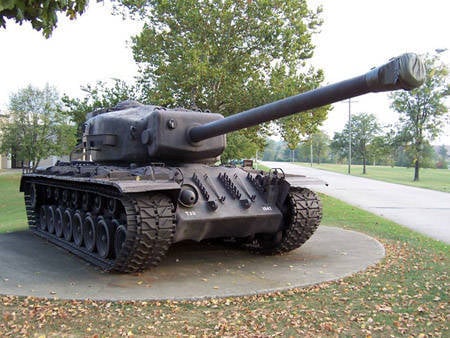
The very phrase "American heavy Tanks"may confound many lovers stories armored vehicles. Have they been? And there were a lot of them? If you ask someone who is more or less interested in "armor", then from American heavy tanks he will recall, perhaps, only the M103, given quite often in our literature as a comparison for the Soviet heavy tank T-10. With some tension, they can remember that the "crown" of the development of British "rhombic" tanks - the heavy Mk.VIII was designed and produced by the British together with the Americans. That's all that took place on the American heavy tanks in the domestic literature. This, in general, reflects the state of affairs in American tank building, but ... oddly enough, a careful study reveals that practically throughout the entire history of tank building, the Americans either had heavy tanks in service or were active in this field. . In fact, only the appearance of the main battle tank Ml "Abrams", whose mass has already reached the mass of the "typical" heavy tank, led to the logical conclusion of the line of development of American heavy tank construction.
English experience "Freedom"
The appearance of the first tanks on the fields of the First World War could not leave the American military and designers indifferent to the new type of military equipment. Quite quickly, a number of original projects were developed, such as a tank with an electric transmission "Holt" and a steam tank developed by the Corps of Engineers, but for mass production it was decided to choose a tank, created jointly with the British and taking into account the experience of the founders of tank building. The main thing that the Americans could offer their overseas allies was the powerful Liberty engine, specially converted from one of the most successful and powerful aviation motors of the period of the First World War. Accordingly, the cooperation between the partners was determined: the Americans supplied the engine and transmission units, and the British supplied body parts, armor and weapons.
The allied tank, often called the "Liberty", was the crown of the British "rhombic" tank building. Its main difference was the large length of the hull - 10,4 m, which was to ensure the overcoming of wide anti-tank ditches. Large size "positively" affected the mass of the tank, which reached 43 tons. The rest of the Mk.VIII resembled its predecessors. The armament consisted of two Hotchkiss 57-mm cannons in onboard sponsons and machine guns in ball cuttings. On British tanks, machine guns were Hotchkiss systems, on the US - Browning Ml 919.
Cruising tank Mk.VIII "Cromwell"
The thickness of the armor plates ranged from b to 16 mm. The layout of the tank differed from the previous "diamonds" by the presence of a partition separating the motor from the control compartment, which had a positive effect on the fire safety and habitability of the tank. The engine "Liberty" was deliberately deformed to 338 hp due to a lower degree of compression. The engine was equipped with an electric starter, but it was hard to start it without the aid of a handle. Chassis included 29 rollers on each side. The speed did not exceed 8 km / h.
According to most materials, the crew of the tank included 11 people. However, according to one of the documents, the crew consisted of eight people: the tank commander, the driver, two gunners, three machine-gunners and a mechanic (he was located in the power compartment). It is possible that this crew was complemented by two more loaders and one machine gunner, that is, it reached 11 people. The landing of the crew in the tank was carried out through the side doors and the hatch in the roof of the cabin of the tank. On the left, the semaphore mast was set up for signaling. Internal communication was carried out using laryngophones. A button-sized microphone was attached to the tanker's throat with an elastic strap. Communication was carried out between the tank commander, driver, mechanic and gunner guns. Communication switch was located at the commander. Moreover, the commander could control the tank outside, keeping in contact with the driver through a long external wire. True, the latter system was abandoned in favor of the flag signaling.
The first "American" tank was made on January 5 1920 of the year. Six months later - June 5 1920 d - the last, hundredth Mk.VIII was handed over. Launching and mastering the tank went with great difficulty because of the whole “bunch” of flaws. Thus, the Liberty tank engine was very fire-dangerous (later this defect went to the BT-2 Soviet tanks along with the same engines - both American and Soviet tankers attempted to start the engine very often ended in extinguishing the fire from hand-held fire extinguishers). Although the tank in the interwar period was well mastered by the troops and was widely used in exercises to accompany the infantry, it soon began to be considered an obsolete machine - the military increasingly favored lighter and more mobile combat vehicles. Things reached the point that in 1936, it was decided to completely exclude the term "heavy tank" from the system of military standards. The tanks themselves were already in storage at the Aberdeen Proving Ground, where they stood until the beginning of the Second World War, after which they were handed over to Canadian troops to train tank crews.
М6-first damn lump
The beginning of the Second World War shifted the American tank building to the dead center. But the emphasis was primarily on light tanks, capable of waging a war of maneuver, carrying out deep breaks to the rear of the enemy. In this case, strong resistance nodes and fortifications were simply planned to be bypassed. The guarantee was the experience of using the German tank forces in the Polish and French campaigns. As a result, at the beginning of the Second World War in the American Tank Division, two regiments were armed with light tanks and only one medium-sized - M3. But even the American military men approached the M3 average very cautiously, hoping to first test the car in a real battle, before giving the green light to its mass production and the increase in the number of tank units it armed. Nevertheless, individual reports of the use of heavy tanks during battles in Europe (for example, the appearance in print of photographs of German three-towed heavy tanks in Norway) could not leave the American military indifferent. As a result of 20 in May 1940, the ground forces commander authorized work on a heavy tank weighing about 50 tons.
American tank M3
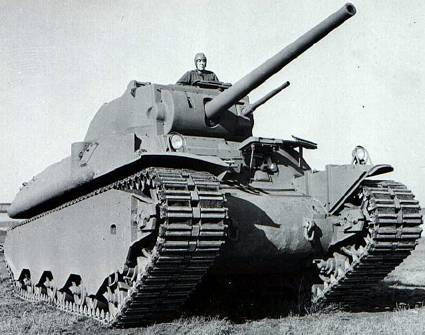
The Americans were not original, like most heavy tanks of the interwar period, they saw a new multi-turbo combat vehicle: four towers — two with 76-mm short-barrel guns, one with an 37-mm cannon and machine gun, and one with an 20-mm cannon and machine gun. This rather retrograde project was approved and received the designation T1. An attempt to build a mock-up of such a fortress on wheels led to a regular adjustment of the project, and it was decided to leave one turret with a wide shoulder strap, but with a long-barreled 76-mm gun based on the T9 anti-aircraft gun in the same mask as the 37-5 XM gun. A turret from the medium tank M1 with a 3-mm machine gun was to be placed on the turret. On the sides of the hull were installed two fixed 7,62-mm machine guns, the fire of which led the mechanic-driver. His assistant was also in possession of the Spark 7,62-mm machine guns in a mobile unit. In addition, an 12,7-mm anti-aircraft machine gun was mounted on the turret on the ring installation.
The main problem in the development of a tank mass 50 tons was the choice of the power plant. After a number of studies, they stopped at the X-NUMX-strong Wright G-960 air-cooled engine with hydro-mechanical transmission. True, later began to work out a variant with the electrical transmission development of the General Electrician. The tank with it was called T200EX1. But by the time the first prototype was ready, both of these transmissions were not yet ready. As a result, they stopped on a mechanical transmission, after which the tank was renamed to Т1Е1. The head assembly company TIE 2 was Baldwin Locomotive Works, which already in August 2 began the first prototype production tests. At the same time the company was preparing mass production.
The very next day after the attack of the Japanese on Pearl Harbor, the T1EX2 was officially presented to the Armaments Department along with the serial model of the medium tank M3. Despite the formidable appearance, the demonstration of the T1EX2 immediately showed serious problems with the transmission. So, during the run of the tank on the landfill he had jammed the brakes and gearbox. As a result, the driver drove the tank with the help of hand brakes and without changing the gearbox. In addition, the tower is wedged.
The tank had to be returned to the workshop for refinement. As a result of the modernization of the exhaust system and the engine cooling fan, the appearance of the power section has changed significantly. The tank was planned to unify the maximum with the serial medium tanks M3 and M4, remove the commander's turret, as well as one of the fixed machine guns.
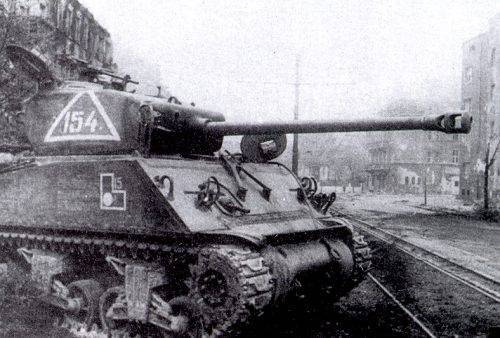
The entry of the United States into World War II forced the US military to hurry up with the launch of a heavy tank series. Т1Е2, it was decided to put into production before the end of the full test cycle, just as they had done earlier with the medium tank M3. The defects identified subsequently were planned to be corrected directly on the assembly lines. The febrile work on launching the tank into the series led to the decision to use everything that was at hand, such as the General-Motor diesel engine and hydromechanical transmission. The hull of the tank at the same time carried out both welded and cast. The tank models with cast and welded hull, Ford engine and mechanical transmission were called T1EX2 and T1X3, respectively. It was decided to purchase 1084 of such machines, renamed 13 of April of 1942 in MB and М6А1, respectively.
Experienced tank T1EX2
By that time, when faced with the problem of mass transport of equipment to overseas theaters of military operations, it was concluded that it was easier to transfer two 30-ton medium tanks overseas than one 60-ton heavy - according to American tankers, the effectiveness of two medium tanks was taller than one heavy. As a result, the order was soon reduced to 115 machines.
Haste with the production of the tank led to the fact that a specially designed hydromechanical transmission was never installed on it. But the tank with electric transmission was successfully tested. According to the test results, it was decided to expand the order to 230 tanks. In this case, the tanks with electric transmission were supposed to come into service with the US Army, and with a mechanical transmission - to be delivered to the lend-leased allies. The new model was even planned to call М6А2. But by that time, the tankers had finally convinced the US Army command of the absence of the need for a heavy tank. As a result, the Army Supply Service decided to discontinue the production of the MB from the 40 machine.
The army, however, experienced already released tanks at the Aberdeen Proving Ground and came to a disappointing outcome: the machines were no good. The armament of the machine, for its weight, was weak, the 37-mm gun was not needed at all, there were serious miscalculations in the layout of the combat compartment. They wanted to fix the situation by installing a 90-mm cannon in the tank, but for this the tower was cramped.
Heavy tank М6А1 on the ground of General Motors
However, almost two years later, after the decision was made to stop serious work with MB, interest again arose in the heavy tank. After the Allies landed in Normandy, the already produced serial machines wanted to be modified - by shielding to bring the thickness of the frontal armor to normal 190-mm and install a new turret with an 105-mm cannon. In total, they planned to remake 15 tanks М6А1, but when the request for the need for such machines was transferred to Eisenhauser, the commander of the Allied forces in Europe, he reasonably noted that there would be little sense from 15 tanks in the European theater. This answer immediately led to the cessation of all work on the tank. True, two samples, designated M6A2EX1, were used to test the 105-mm guns in the new turret for the new heavy tank Т29. In December 1944, all tanks of the T1Е1, MB and М6А1 series were decided to be scrapped. One car remained in the collection of the tank museum of the landfill in Aberdeen.
Super heavy tank T28 - self-propelled gun T95
In general, the cessation of work on the M6А2Е 1 was primarily due not to the distrust of the American military to a heavy tank, but to a small number of vehicles suitable for conversion. Work on the new breakthrough heavy tanks has already been underway since September 1943.
Preparing to open a second front in Europe, the US military agreed that in order to break through long-term defensive positions like the German Zapadny Val, a heavy tank would be needed with the highest possible booking and a powerful gun to destroy concrete long-term defensive structures. After long negotiations between the military and the Armaments Department, in March 1945 it was decided to order five tanks under the designation T28 weighing up to 95 tons with 305-mm frontal armor and 105 mm T5-X1 gun.
Given the large thickness of the armor, it was decided to make the tank reckless with the installation of the 105-mm gun in the frontal part of the hull. Auxiliary armament in this case should consist only of anti-aircraft 12,7-mm machine gun on the commander's turret. Since they planned to use the Ford-GAF 500-strong engine from the Pershing M26, there were problems with the mobility of such a heavy machine. It was decided to install two pairs of tracks on each side. At the same time, the external tracks could be dismantled by the crew and towed behind the tank while driving on the highway. Given this layout of the machine, it was decided to rename it into self-propelled gun T95.
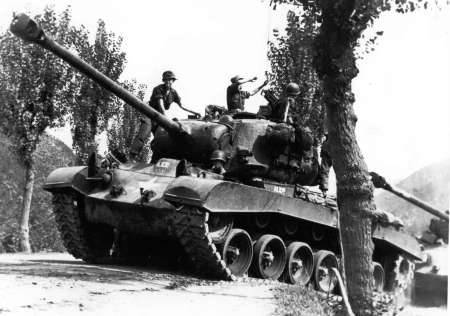
Due to the heavy load of industry, military orders could not find a contractor for the manufacture of these self-propelled guns for a long time. In the end, the agreement was granted by the Pacific Car and Foundary Company, which in May 1945 began work. By August 1945 r the first building was assembled. But with the end of the war on the Pacific, the Americans limited themselves to releasing only two self-propelled guns. The first of them was sent to the Aberdeen Proving Ground in December 1945 g, the second - in January 1946 g.
T95
Heavy Assault Tank
Tests have shown that T95 has a very small speed of movement - not more than 12 km / h. However, in the process of testing self-propelled guns "wound on a caterpillar" of the order of 865 km, including 660 km in virgin soil, which, given the low speed of the car, took quite a long time. Heavy armored, with powerful armament self-propelled gun T95 did not fit into the concept of armored weapons of US Ground Forces. Thus, the tanks had to have a turret, and self-propelled guns were usually easily booked for maximum mobility. T95 did not fit either there or there. As a result, in June 1946 g, the name was again changed - the car again became a heavy tank T28. Nevertheless, the work on the T28 stopped - the 100-ton weight for the tank was considered redundant.
One T28 is now stored in the museum's collection at Fort Knox.
The answer to the "Royal Tiger"
In addition to interest in breakthrough heavy tanks, the work of the Americans in the field of heavy tank building was spurred by reports of Germans using their heavy tanks in Europe. And if the average Pershing tank, called heavy rather to calm the crews, was a kind of response to the heavy German Tiger tank, familiar to Americans from the 1943 G, then the appearance of even more powerful German heavy machines like the King Tiger and Jagdtigr, "led to the decision to start work on two types of heavy tanks at once. One of them with the 105-mm cannon received the designation T29, the second - with the 155-mm - T30. Characteristically, it was immediately planned to order as many 1200 T29 tanks.
Royal tiger
Jagdtigr
A distinctive feature of the 70-ton tank was a new cross-drive hydromechanical transmission, combining gearbox and brakes in one unit. The transmission first had a purely electric remote control, but the driver’s lack of “tank feeling” led to the decision to return to the mechanical control wiring, leaving only the speed switch electroplaned. The engine was originally chosen by the Ford GAC XHUMX horsepower. In the undercarriage, the nodes from the "Pershing" were widely used, for example, tracks of tracks, only broadened to 770, see.
Experienced heavy tank T30. This tank was developed in parallel with the T29
The tank hull was welded from cast and rolled parts. The tower was cast. The maximum thickness of the armor of the turret reached 175 cm, and the hull is 100 mm with a tilt angle of 54 °. The armament consisted of 105-5 1-mm cannon with 63 ammunition. Two 12,7-mm machine guns mated with a gun. Another machine gun was on the roof of the tower in front of the loader hatch. The crew consisted of six people: the driver and his assistant - in the office of management; the commander is in the niche of the tower; gunner - on the right side of the tower; two loaders - on the sides of the breech of the gun.
On April 12, 1945, together with an order for mass production at the Press Steel Car Company, it was decided to manufacture four experimental tanks. By the time the war in the Pacific ended, the company managed to assemble only one experimental tank, after which a decision was made to stop mass production. True, a little later at the Daytroit arsenal they planned to assemble another 10 tanks for various tests. Soon, their number was reduced to eight.
In reality, the first 29 was put up for testing only in October of 1947. By that time it was clear that the tank had no prospects, and its tests were intended only for evaluating various components with an eye to the possibility of using them on promising tanks.
Experienced heavy tank T29
On eight T29 test tanks, the Allison V-1710-Е32 HP engines were tested. with a cross-drive CD-870 transmission, hydraulic tool guidance mechanisms along with a ballistic computer developed by the Massachusetts Institute of Technology, various 850-mm X105 gun mounts, a number of panoramic sights, and a special range finder.
Soon, two T29 tanks joined the T30 tanks, the main difference of which was the Continental AV-1790-3 engine with a power of 810 hp. Actually testing this engine and transmission CD-850 became the main purpose of the work on these two experimental tanks. In addition, the 30-mm T29 gun was mounted on a T155 in a turret similar to the T7 tanks. The weight of the projectile reached 43 kg, and the total weight of the shot - 61 kg. This limited the ammo to 34 shots only. The use of a heavy projectile forced the use of spring rammer. But even before the test of the tank, it was clear that an automatic loader mechanism was needed. Such a device was mounted on one T30. Charging at the same time occurred at a constant angle of inclination of the gun. In addition, the loader had a special device for lifting projectiles inside the tank. Externally, a tank with an automatic loader differed only in a flap for ejection of spent cartridges.
Nevertheless, the armor penetration capability of the 155-mm guns did not satisfy the US Department of Arms, and there they decided to create a 120-mm tank gun based on an anti-aircraft gun. The initial speed of an armor-piercing projectile of such a weapon was estimated at 1250 m / s compared to 1128 m / s for 105-mm guns Т5 and 700 m / s for 155-mm guns Т7. With the new 120-mm T53 tank gun, it was decided to re-equip both the T30, renamed for the occasion to the T34. Externally, the new tanks differed from the T29 and T30 only in the new weapon and the 100-mm counterbalance plate welded to the rear of the turret.
The very first tests of the T34 showed that gas concentration in the fighting compartment sharply increased, and sometimes particles of unheated powder of the propellant charge were ejected from the open bore of the barrel, which resulted in burns of several tank crews. Initially, the barrel bore was blown with compressed air, but then they stopped at the muzzle ejector, which tried to solve this problem completely. After successful fire tests on the T34, the muzzle ejector firmly settled on American tanks.
Т32 - heavy from medium
The experience of fighting American armored forces in Europe showed that in addition to powerful weapons, the tank also required powerful armor. As a result, the headquarters of the Land Forces came up with the initiative to create a highly armored heavy tank on the basis of the medium "Pershing" tank. The solution of this task was seen by American tank builders in two directions: a simple refinement of the "Pershing" by enhancing its reservation and reworking the transmission to preserve its mobility (the result was the T26EXNNXX tank, later reclassified into an average tank), or the creation of a new heavy tank with maximum use nodes "Pershing". The latter led to the appearance of the heavy tank T5, four prototypes of which were ordered in February 32.
The design work on the T32 went very quickly due to maximum unification with other tanks of the already developed units: the engine and transmission were taken from the heavy T29; Chassis, adding one track roller - from the "Pershing." On the first two tanks there is a frontal part of the hull with a maximum thickness of 127-mm at an angle of inclination of 54 °. was cast, on the next two - they were called T34EX1 - rolled, welded. The armament was to consist of a 90-15 2-mm cannon with a maximum initial velocity of an armor-piercing projectile in 1143 m / s and two 7,62-mm machine guns.
The first two T32 prototypes were ready at the beginning of 1946 g, and at the beginning of the summer they were joined by two Т32Е1 - that is, earlier than heavy tanks NXXX. As a result, the T29 was the first to test the transmission of the cross-drive type EX-32, which, after improvements, under the name CD-120, became standard for many American tanks. In fact, testing of individual components for the future generation of American armored vehicles was the main task of the T850 tests. Actually, by the end of the Second World War, neither Т32, nor Т32-Т29-Т30 had ripened, and, therefore, no prospects for mass production ...
М103 - the crown of American heavy tanks
Immediately after the end of the Second World War, the development of new American heavy tanks stalled, and only the cooling of relations with its former ally, the USSR, made it necessary to leisurely begin work in this direction. As a model, the Soviet heavy tank EC-3 stood before the eyes of American tank builders and made a great impression on them. The Soviet EC-29 favorably differed from the American heavy tanks of the T34-T3 series with a lower weight with a higher level of body armor and adequate power of weapons. As a result, in the US, a specially created commission under the direction of General Stilwell recommended creating a new heavy tank, designated T43, based on T34 by reducing its weight from 70 to 58 tons due to the shorter body and reducing the crew to four people (automatic loading was introduced). In addition, the 120-mm lightweight gun should have been put on the tank. To maintain the level of protection with less weight of armor, it was planned to use widely cast parts (the weight of the tank was reduced to 55 tons). A mockup commission conducted at the Deitroit Arsenal, in December 1949 g, recommended eliminating the automatic loader and introducing a second loader into the crew.
The work on T43 went rather sluggishly, until in June 1950 the Korean War began and the threat of the use of Soviet IP against American troops did not arise. It immediately became clear that the American armored forces could not oppose anything to the Soviet heavy vehicles. Work on the T43 immediately accelerated and at the same time an order was issued for the 300 serial and several experienced tanks. Already in June, the Chrysler firm 1951 supplied the first Т43 for testing. The tank was armed with an 120-mm gun T 122 with the initial velocity of the projectile in 1007 m / s. On the experienced tanks there was a commander's turret from the M47 tank, and on the first production tanks - from the M48 tank with an 12,7-mm machine gun. The tank inherited from the heavy Т29-Т34 engine "Continental" АV-1790 with horsepower 810. and the CD-850 transmission. At the same time, the undercarriage had fewer support rollers on each side.
The entire series of 300 tanks was released by Chrysler in 1953-54. Its acceptance was carried out according to the results of tests of the sixth experimental and eighth serial tanks. However, the rush with the manufacture of the tank — the gun guidance and fire control systems — did not work satisfactorily (practically they had to be replaced with new ones), the tower niche was heated from the power compartment, and exhaust gases got into the control compartment. According to the results of the tests in the tank should make at least 100 various changes and improvements. As a result, in 1955, it was decided to send all 300 tanks for storage - T43 was not accepted into service with the Army.
In order not to disappear "good" the army decided after minor modifications to adopt the 74 T43 tank, which then received the designation "120-mm battle tank Ml 03" (the classification of American tanks after the war was adopted according to the caliber of the gun). On these tanks they put a new commander's turret with an 12,7-mm machine gun. With the 120-mm gun on the M103, two 7,62-mm machine guns were paired. The power plant of the AV-1790-5B engine and the CD-850-4В transmission worked quite satisfactorily, they just installed an exhaust deflector so that they would not heat the turret.
We decided to finalize the fire control systems on an experienced T43EXNNX tank. Instead of hydraulic ones, electric gun drives were placed on it, and one of the paired machine guns was replaced with a telescopic sight. The tank received a stereoscopic rangefinder with automatic data transfer to the gunner's ballistic computer. At the same time, the 2mm machine gun was removed from the commander's turret. Many have suffered with a special deflector muzzle gases - he muzzle brake. The main purpose of the deflector was to reduce a cloud of powder gases, dust and dirt, which was formed when fired from such a powerful gun and almost covered the target for the gunner. There was little confusion from the deflector and it was soon removed altogether.
The new version, which received the designation М103А1, already fully met the requirements of the army, but it did not plan to order new heavy tanks. The position was saved by the Marine Corps, which ordered rework in the M103-1 219 T43 tanks. All ordered МХNUMXА103 were delivered to the corps until July 1 of the Army, however, the same did not stand aside and took "loans" from the 1959 МХNUMXА72 marines.
In 1961, the Marine Corps decided to re-equip the M103А1 tanks under the Continental AVDS-1790-2A diesel engine. The power reserve increased from 130 to 480 km. The tank was also equipped with a system for reducing visibility in the infrared. Almost completely updated sighting equipment, added an infrared illuminator. The new version of the tank was put into service under the designation МХNUMXА103. After testing with these modifications of the experimental tanks M2A103EX1 in August 1, an order was issued for the conversion of 1962 tanks M153X103. In 1. Thus, the 1968 of the M53А103 tank was further developed, bringing the total number of M1А103 to 2 together with the experienced ones.
As part of the Marine Corps, the M 103 tanks were used by fourth companies in three tank battalions, as well as in reserve units. In the ranks, they remained until 1973, when they were replaced by the latest models of the main battle tank M60.
In general, during the entire post-war period, the main motive for working on heavy tanks in the United States was the presence in the USSR Army of heavy EC-3, and later T-10. American tankers themselves never favored heavily armored vehicles - they clearly lacked mobility, especially those valued at military exercises. But it was enough for the same tankers to be under enemy fire, as they immediately hung on their cars additional trucks, bags of cement, spares of spare parts, etc., trying as much as possible to improve the security of the tanks. It was the same with tank auxiliary armament. Vietnamese experience has shown that a coaxial machine gun rifle caliber and 12,7-mm anti-aircraft machine gun is not enough to suppress enemy infantry. Therefore, ancillary weapons tried in every way to strengthen, often changing the gunner's periscope sight to another coaxial machine gun. That is, the solutions used on the heavy tank M103, were fully confirmed in a combat situation.
The first generation of main battle tanks, such as the M48 and the M60, consisted of the development of medium tanks of the second world war, which required their addition to the battle formations with heavier vehicles, like the M103 tank. The appearance in service of the new generation of main battle tanks of the Ml type actually meant the full implementation of the requirements for this type of combat vehicles both in armor protection and armament, typical of heavy tanks, and in mobility, according to which Ml was practically equal to many light tank models. Therefore, the beginning of work on the tank Ml and put a logical point in the history of the development of American heavy tank construction.
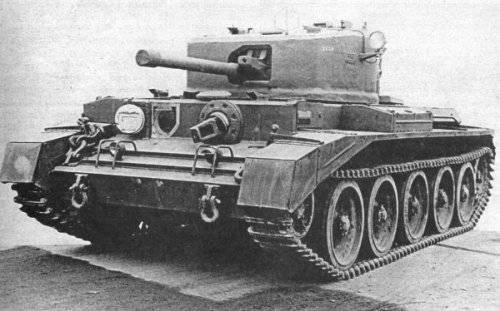
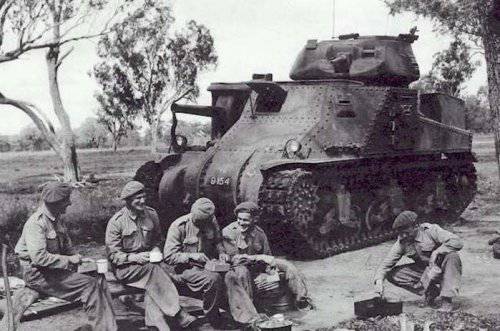
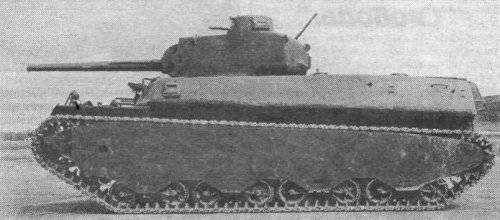
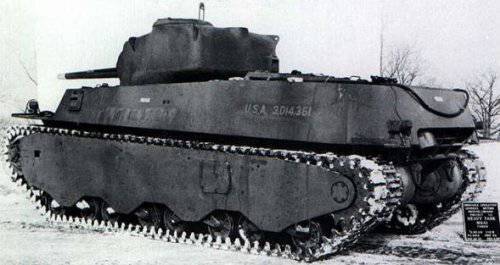
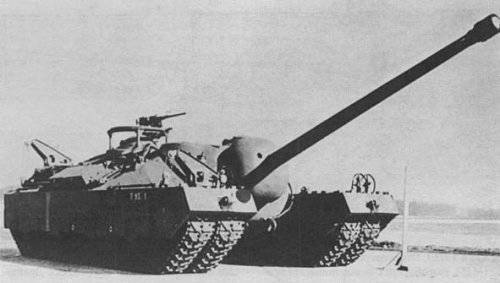
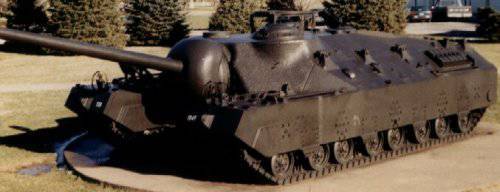

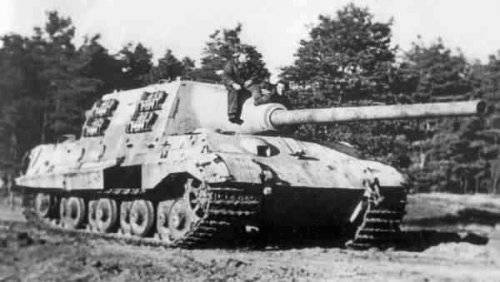
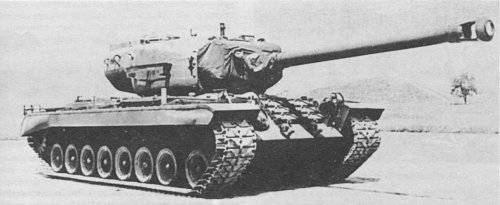
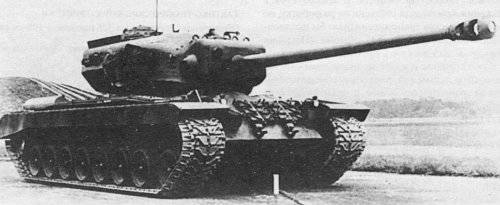
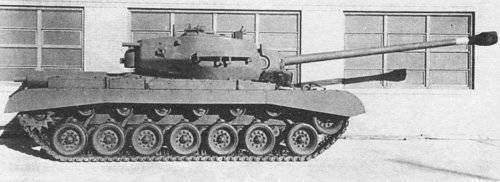
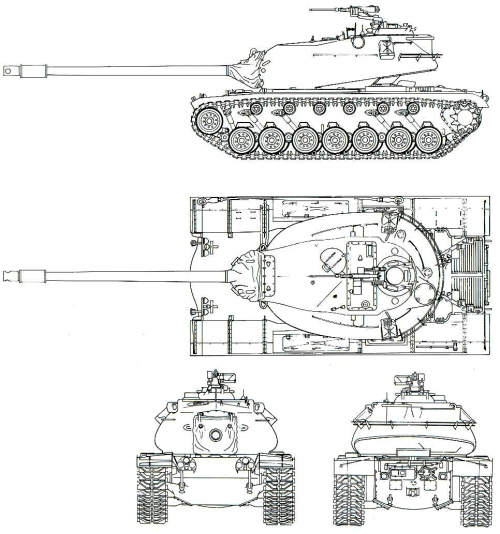
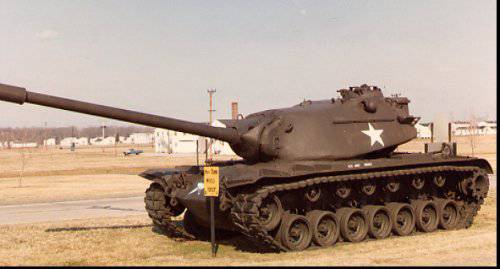
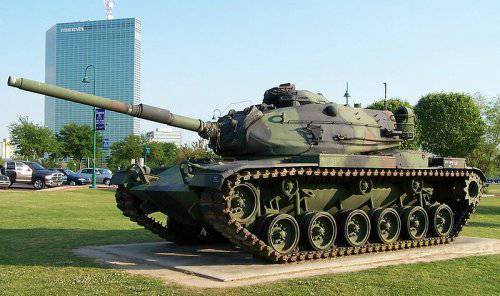
Information